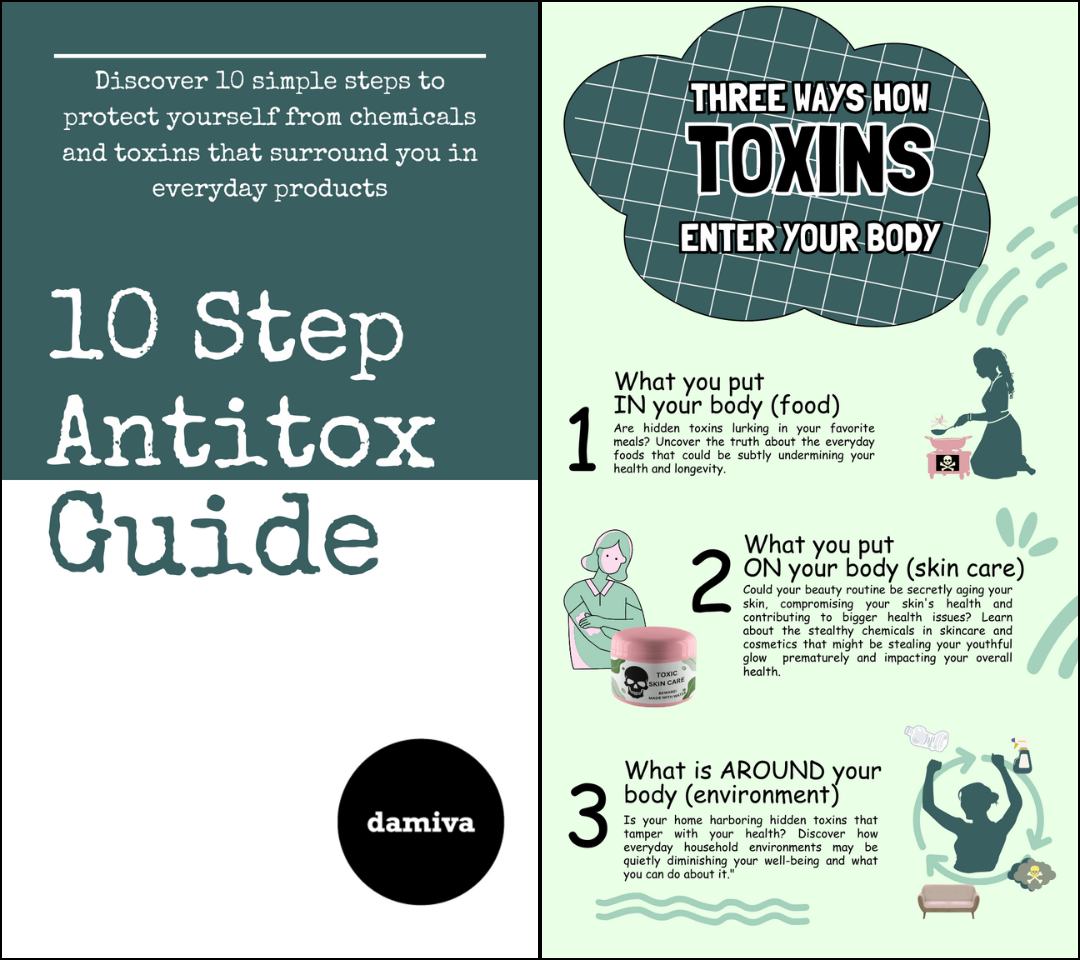Introduction
Understanding Endocrine Disruptors
Endocrine-disrupting chemicals (EDCs) are substances, either natural or man-made, that can interfere with the body’s endocrine system. These chemicals can mimic, block, or otherwise interfere with hormones, which are the body’s chemical messengers responsible for regulating various physiological processes. EDCs are found in a wide range of products, including cosmetics, food packaging, toys, and pesticides. Due to their prevalence, it is nearly impossible to completely avoid exposure to EDCs. However, understanding their sources and mechanisms of action is the first step in mitigating their potential health effects.
The Impact of Endocrine Disruptors on Health
The health implications of EDC exposure are significant and far-reaching. Even minor disruptions in hormone levels can lead to developmental, reproductive, neurological, and immune issues. Research has linked EDCs to a variety of health problems, including infertility, hormone-related cancers, obesity, and developmental disorders. The effects of EDCs can be particularly profound during critical periods of development, such as in utero and during childhood, making it crucial to understand and manage exposure during these times.
The Importance of Avoiding Endocrine Disruptors
Avoiding EDCs is important for maintaining overall health and preventing disease. While it is challenging to eliminate exposure entirely, there are steps individuals can take to reduce their risk. These include making informed choices about the products they use, advocating for policies that limit EDCs in consumer goods, and staying educated about emerging research. By taking proactive measures, individuals can help protect themselves and their families from the potential hazards associated with endocrine disruptors.

Do you have the most commonly used but toxic, disease bringing chemicals in your skin care? Many chemicals in skincare are hormone disruptors and make menopause symptoms worse.
Find out more…
Identifying Common Endocrine Disruptors
Categories of Endocrine Disruptors
Endocrine disruptors are a broad group of chemicals that can interfere with the endocrine system, the network of glands that produce hormones. These disruptors can be categorized based on their source and structure into several groups, including heavy metals like mercury and lead, pesticides such as DDT and atrazine, industrial chemicals like dioxins and polychlorinated biphenyls (PCBs), plasticizers such as bisphenol A (BPA) and phthalates, and phytoestrogens which are naturally occurring in plants.
Sources of Endocrine Disruptors in Daily Life
Endocrine disruptors are found in a variety of everyday items. They can be present in food and beverage packaging, particularly in plastics and can linings, personal care products like cosmetics and shampoos, household products including cleaners and air fresheners, and even in the environment due to agricultural runoff and industrial waste. Awareness of these sources is the first step in reducing exposure.
Endocrine Disruptors and Personal Care Products
Personal care products are a significant source of endocrine disruptors. Substances such as phthalates and parabens are commonly used in these products for their ability to stabilize fragrances and act as preservatives. To minimize exposure, opt for products labeled as “paraben-free” or “phthalate-free” and avoid those with vague ingredients like “fragrance,” which can be a mix of undisclosed chemicals.
Endocrine Disruptors in Household Products
Household products, including cleaning agents, furniture, and electronics, often contain flame retardants and other chemicals that can act as endocrine disruptors. Regular dusting and vacuuming with a HEPA filter can reduce the accumulation of these substances in your home. Additionally, choosing eco-friendly cleaning products and being cautious with plastics can further decrease exposure to these harmful chemicals.
By the way, something for you, a little gift!!!
I am just in the middle of publishing my book. It’s about How women can balance their hormones. One part is about food and diet, of course.
Follow this link and enter your email.
I will send you this part of the book for free once the book is published. It has many concrete, practical tips and recipes and will help you feel better during menopause or times of Big hormonal fluctuations.
Annette, Damiva Lead for Health & Wellness

Food and Nutrition
Choosing Organic and Locally-Sourced Foods
One of the most effective ways to reduce exposure to endocrine disruptors found in pesticides and herbicides is to opt for organic and locally-sourced foods. Studies have shown that consuming organic foods can significantly reduce the levels of certain EDCs, such as bisphenol A (BPA) and phthalates, in the body. By choosing organic, you are also supporting farming practices that are less harmful to the environment and more sustainable in the long term. Locally-sourced foods are often fresher, have a smaller carbon footprint, and are less likely to be contaminated during long transportation processes.
Understanding Food Labels and Additives
Food labels can be a minefield of information, but understanding them is crucial to avoiding EDCs. Look for labels that indicate no artificial preservatives or additives, as these can often be sources of harmful chemicals. Be wary of products that list “fragrance” or “flavor” as these can be code for phthalates. Additionally, be cautious of plastics labeled with recycling codes 3, 6, or 7, as these may contain phthalates and BPA. Instead, seek out products packaged in glass or BPA-free containers.
Cookware and Storage Containers
The containers and cookware we use can also contribute to our intake of EDCs. Studies have indicated that stainless steel and glass are safer alternatives for storing and cooking food compared to plastic containers, which can leach chemicals like BPA into food, especially when heated. When it comes to cookware, non-stick pans coated with perfluoroalkyl substances (PFAS) should be avoided. Instead, opt for cast iron, stainless steel, or ceramic options that do not release toxic fumes or particles into your food.
Personal Care and Beauty Products
Selecting All-Natural Skincare
When it comes to skincare, the adage “less is more” often holds true, especially in the context of endocrine disruptors. Opting for 100% natural, chemical-free skincare products can significantly reduce your exposure to harmful chemicals. Look for products with a minimal ingredient list, ideally those that are plant-based and free from synthetic additives. Avoid products that contain water because water is a breeding ground for bacteria, so these products need preservatives to inhibit growth of bacteria and germs. Remember, your skin is your largest organ and what you put on it can be absorbed into your bloodstream, potentially impacting your hormonal health.
Avoiding Harmful Ingredients in Cosmetics
Many cosmetics contain a cocktail of chemicals that can act as endocrine disruptors. To protect your health, it’s crucial to avoid harmful ingredients such as parabens, phthalates, and synthetic fragrances. These substances can mimic hormones and cause imbalances. Use resources like the Environmental Working Group’s Skin Deep database to check the safety of cosmetic ingredients and products. Additionally, consider reducing the number of cosmetic products you use daily to limit your overall exposure.
- Parabens (methyl-, isobutyl-, propyl- and others)
- Phthalates (DBP, DEHP, DEP and others)
- Synthetic fragrances (often listed as “fragrance” or “parfum”)
- BPA
- BPS
- Triclosan
- DEA (Diethylamine)
- Sulfates
- Alcohol
- Petrolatum
- PEGs (Polyehtylene Glycol)
- BHT, BHT, BPF BPB
Alternatives to Traditional Fragrances
Traditional fragrances in personal care products are often a complex mixture of undisclosed chemicals, including phthalates. To avoid these potential endocrine disruptors, seek out alternatives to traditional fragrances. Choose fragrance-free products or those scented with natural essential oils. However, be mindful of the concentration and quality of essential oils, as they can also cause skin sensitivities if not used appropriately. Additionally, consider using natural odor eliminators in your home, such as baking soda or vinegar, to maintain a fresh environment without the need for synthetic fragrances.
In conclusion, by being vigilant about the personal care and beauty products you choose, you can significantly reduce your exposure to endocrine disruptors. Embrace natural and organic skincare, scrutinize cosmetic ingredients, and opt for natural fragrances to support your endocrine health and overall well-being.
Do you know the 3 main ways how your body is exposed to harmful chemicals, which affect your hormones, your thyroid, health and beauty?
If not, it may be time to learn about them. It takes about 1-2 minutes.
We have a few suggestions how to avoid these silent health and immune system killers in our new guide.

Home and Environment
Eco-Friendly Cleaning Products
When it comes to maintaining a clean home, the products we use can have a significant impact on our health and the environment. Many conventional cleaning products contain endocrine-disrupting chemicals (EDCs) that can interfere with our hormonal systems. To reduce exposure to these harmful substances, opt for eco-friendly cleaning products. Look for items with the Safer Choice label, which indicates that the product’s ingredients have been reviewed by the Environmental Protection Agency (EPA) for safety. Additionally, consider making your own cleaners using household staples like vinegar and baking soda, which are effective and free of EDCs.
Furniture and Building Materials
Furniture and building materials in our homes can be sources of EDCs, such as flame retardants and volatile organic compounds (VOCs). When purchasing new furniture or renovating your home, seek out products labeled as flame-retardant-free and choose materials with low or no VOC emissions. Materials such as solid wood, bamboo, and natural fiber textiles are healthier alternatives to those treated with harmful chemicals.
Improving Indoor Air Quality
Indoor air quality is crucial for a healthy home environment, as EDCs can accumulate in household dust and air. To improve air quality, dust with a damp cloth and use a vacuum with a HEPA filter to trap small particles. Avoid synthetic fragrances, which often contain phthalates, by choosing fragrance-free products or using natural alternatives like fresh flowers or baking soda to combat odors. Additionally, ensure good ventilation by opening windows and using fans to circulate fresh air, and consider adding indoor plants that can help filter the air naturally.
By making conscious choices about the products we use in our homes, we can significantly reduce our exposure to endocrine disruptors and create a safer, healthier living environment.
Lifestyle and Habits
Stress Management and Hormonal Balance
Stress is an often overlooked factor that can significantly impact hormonal balance. Chronic stress leads to elevated cortisol levels, which can disrupt the delicate balance of hormones in the body. To manage stress and maintain hormonal equilibrium, consider incorporating relaxation techniques such as deep breathing exercises, meditation, or yoga into your daily routine. Regular physical activity is also essential, as it helps to reduce stress hormones and stimulate the production of endorphins, the body’s natural mood elevators. Additionally, ensuring adequate sleep is crucial for hormonal regulation, as the body repairs and regenerates during this time.
Clothing and Textile Choices
The clothes we wear and the textiles we use in our homes can be sources of endocrine disruptors, particularly when they are treated with flame retardants or stain-resistant chemicals. To minimize exposure, opt for clothing made from natural fibers like organic cotton, linen, or hemp, which are less likely to be treated with harmful chemicals. When purchasing new furniture or textiles, look for items that are free from added flame retardants and have certifications such as Oeko-Tex or Greenguard, indicating lower levels of chemical emissions.
Incorporating Detoxifying Activities
Detoxifying activities can help reduce the body’s burden of endocrine disruptors. Regular exercise promotes the elimination of toxins through sweat and supports the body’s natural detoxification systems. Dry brushing, a technique that involves using a natural-bristle brush to gently brush the skin, can stimulate the lymphatic system and aid in the removal of toxins. Additionally, consuming a diet rich in antioxidants, fiber, and cruciferous vegetables can support liver function, a key organ in the detoxification process. Finally, consider using a sauna, which can further promote the elimination of toxins through sweating, but always consult with a healthcare provider before starting any new detox regimen.
Empowerment Through Education
Staying Informed on Health and Safety
Knowledge is power, and when it comes to endocrine disruptors, staying informed is the first step towards safeguarding your health. Endocrine disruptors are chemicals that can interfere with the body’s hormonal system, potentially leading to adverse developmental, reproductive, neurological, and immune effects. To protect yourself and your loved ones, it’s essential to be aware of where these chemicals are commonly found and how to avoid them. Regularly reading up on scientific research, attending health seminars, and following trusted health and wellness blogs can keep you updated on the latest findings and recommendations.
Community Involvement and Advocacy
Individual actions are important, but collective efforts can lead to broader change. By getting involved in community initiatives and advocacy groups, you can help raise awareness about the dangers of endocrine disruptors. Participating in local environmental clean-ups, advocating for policies that regulate harmful chemicals, and supporting organizations that fight for a cleaner, safer environment can amplify your impact. Together, communities can push for greater transparency in product labeling, stricter regulations on chemical use, and the development of safer alternatives.
Resources for Continued Learning
Continuing education on endocrine disruptors is crucial for making informed decisions about your health. There are numerous resources available for those who wish to delve deeper into this subject. Academic journals, government health websites, and non-profit organizations offer a wealth of information. For instance, the Environmental Working Group provides guides for identifying safer products, while the National Institute of Environmental Health Sciences offers updates on the latest research. Additionally, documentaries and books on the topic can provide comprehensive insights into the prevalence of endocrine disruptors and their impact on health.
By staying informed, getting involved, and utilizing available resources, you can empower yourself to make healthier choices and advocate for a safer environment. Education is not only about acquiring knowledge but also about applying that knowledge to create positive change in your life and the world around you.



















